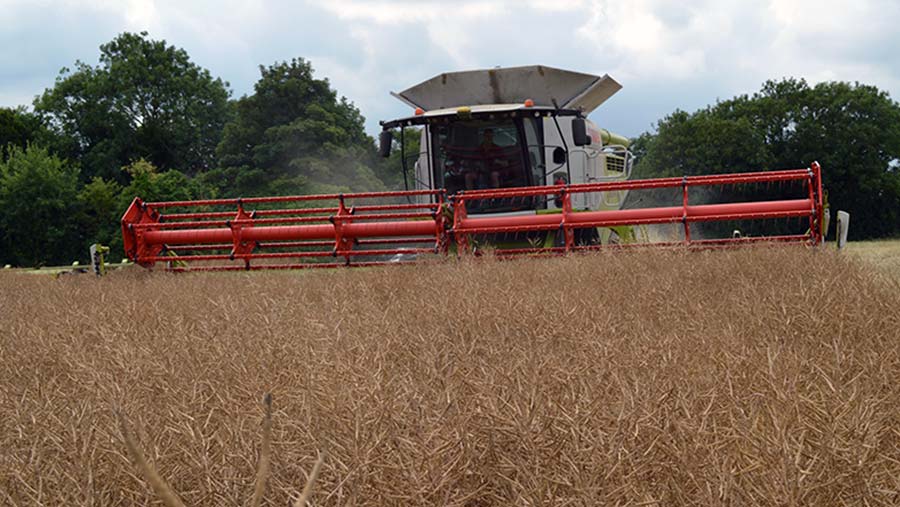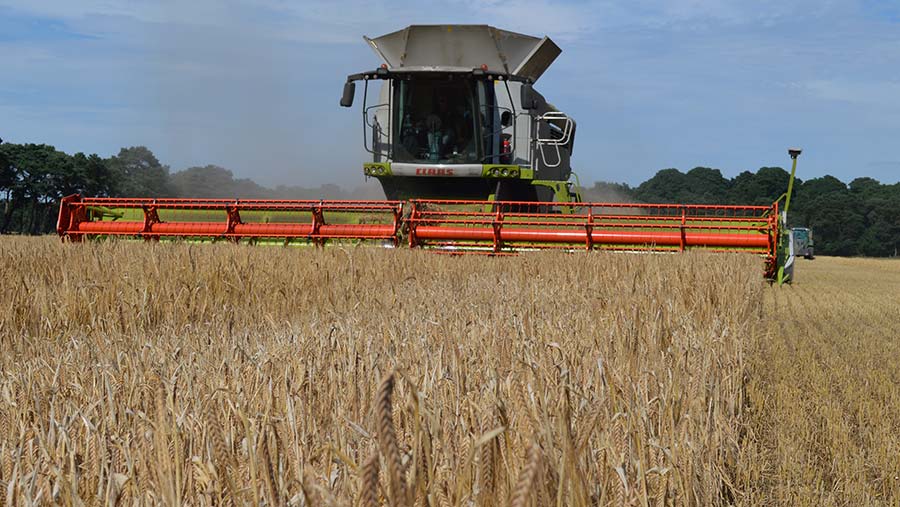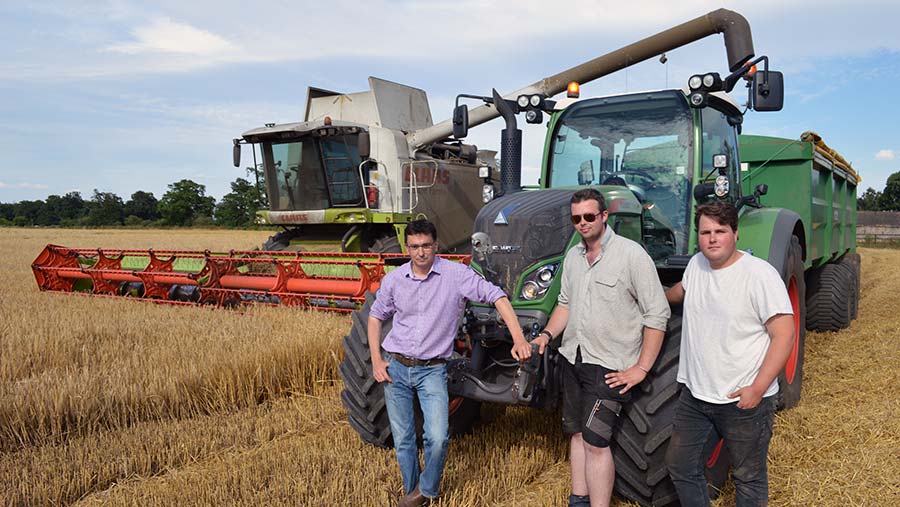Harvest 2017: Early rapeseed yields better than expected in dry year
Early oilseed rape yields look better than expected in a harvest that has started nearly two weeks early, while combining of winter barley gathers pace across southern England.
After a difficult, dry growing season, rapeseed yields are surprisingly good, with early estimates putting average yields at 3.6t/ha, higher than last season’s 3.1t/ha.
Those first to harvest are pleasantly surprised after dry weather hit early autumn establishment and brought maturity forward, prompting fears of low yields.
See also: Harvest 2017 video: Suffolk barley yields good despite dry spring
James Loder-Symonds in east Kent reports that yields are better than he initially thought, and are gradually rising up to 3.8t/ha as he moves through his 300ha of rapeseed in his farm’s earliest-ever harvest.
“On our better land, the variety Flamingo is yielding 3.8t/ha, which is better than expected after dry weather at establishment and then early spring,” he told Farmers Weekly.

© David Jones/RBI
Early start to harvest
The rapeseed harvest started on 6 July at Mr Loder-Symonds’ Nonington Farms, between Canterbury and Dover, which was 10 days earlier than normal. He grows 1,200ha of combinable crops on soils ranging from brickearth clays to chalky soils on the edge of the North Downs.
His combine’s first foray into a rapeseed crop was into a field of Flamingo on some very light soil drilled late in the second half of August.
Watch the full video report on the oilseed rape harvest at Nonington Farms below.
“This produced a disappointing yield of 3.2t/ha, but yields have climbed as we have moved into crops on better soils,” he added.
The better-yielding Flamingo at 3.8t/ha was sown on 10 August along with some Picto, which yielded 3.75t/ha, put against a farm average yield of 3.5-4.0t/ha.
These earlier-drilled crops allowed the rapeseed to establish better in the dry autumn, and grow away from pests such as cabbage stem flea beetle and pigeons, and he is reasonably pleased with the yields so far.
Surprised by early yields
Further north, Essex grower David Lord kicked off his oilseed rape harvest on 9 July, again some 10 days earlier than last year, and he is pleasantly surprised with initial yields, estimated at 3.8t/ha.
Imperial, a Clearfield variety from Monsanto, harvested on Mr Lord’s heavy London clay soil at Earls Hall Farm, near the coast close to Clacton-on-Sea, showed a higher yield from last year’s average of 3.5t/ha.
Mr Lord says it had been a difficult growing season after a prolonged dry spell in the autumn saw more than half of the crop fail, with the remainder only saved thanks to irrigation.
Heavy land crop
Over in Cambridgeshire, Thomas Martin started his oilseed rape harvest on 10 July, much earlier than last season, and was seeing yields of 3.6t/ha from his crop of the variety Campus.
Yields are similar to last year and with no significant rain for two weeks, moisture levels were a low 7% on his heavy land at Haddon, in the north of the county close to Lincolnshire and Northamptonshire.
Mr Martin said his heavy clay soils had kept the roots in moisture at all times, meaning the crop still required desiccation, unlike some nearby crops that had burnt off.
Average yields
Owen Cligg, trading manager at co-operative United Oilseeds, says he is hearing reports of yields between 3.0t/ha to 4.2t/ha.
“What could have been a very good crop has been curtailed a bit by the early harvest, and we are now looking at a good average year,” he said.
He expects national yields to average 3.6t/ha to give a 2m tonne crop, but believes seed ordering for next season will be late as many growers are nervous about cabbage stem flea beetle and want to be confident they can create good seed-beds to limit damage from this pest.
Philip Kimber, oilseeds trading manager at Frontier, says the current crop looks promising and believes the drilling area for next season may be higher due to good current rapeseed prices.
See also: Decline in oilseed rape area forecast to halt next season
He is looking for a crop of 1.8-2.0m tonnes and believes with current ex-farm price at £310-£315/t, this will encourage a bigger area of the crop next season.
“Prices are signalling that oilseeds are in demand and the UK needs a crop of more than 2m tonnes to satisfy the crushers and allow some for export,” he said.
Breckland harvest
On the winter barley harvest, two big Suffolk Breckland estates are reporting good yields despite the dry, early spring that hit this light blow-away, sandy land.
Both the Elveden and Euston estates, in the north-west of the county, started harvest early as a dry June and July brought crops to maturity quickly, with yields and grain quality better than feared after the dry weather.

© David Jones/RBI
The vast Elveden Estate grows 700ha of winter barley, and assistant farm manager Tom Forrest says they have had the earliest-ever start to the cereal harvest on 3 July.
Watch the video report of the winter barley harvest at Elveden Estate below.
One high-value seed crop of Flagon received 25mm of irrigation in the dry April and yielded 8.2t/ha, but unirrigated crops of the six-row hybrid Bazooka did 7.2t/ha and the two-row malting variety Venture managed 6.6t/ha.
This is set against the yield budget of 7.0-7.5t/ha for the 8,800ha estate, which also grows winter wheat, rye and spring barley and an array of vegetables.
“We have made a reasonable start to harvest. The irrigated crops were good and the others were below average, but given the very dry spring, we cannot grumble,” said Mr Forrest.

From left: Euston Estate farm manager Matthew Hawthorne, Pete Matsell and Oliver Tyrrell © David Jones/RBI
Euston steaming ahead with harvest
A few miles east on the 4,200ha Euston Estate, farm manager Matthew Hawthorne has 330ha of winter barley to cut and is seeing good results.
He started cutting 80ha of the variety Tower on 7 July and yields are averaging 7.5t/ha at a moisture of 13.5% and a good specific weight of 70kg/hl.
Watch Euston Estate’s winter barley harvest in action below.
“In this season when April was so dry, this is a good yield. April is a make-or-break month on this farm. If April is wet, you are fine. If not, you can struggle,” he said.
The estate grows 680ha of winter wheat and barley, along with sugar beet, vegetables and maize. Once the Tower winter barley is finished, there is a 250ha seed crop of Volume to cut.
Harvest 2017: how to get involved
Make sure you’re up to date with all the latest harvest 2017 developments by following Farmers Weekly’s Harvest Live Twitter account, liking our Facebook page, and following us on Instagram.
You can get all the news and analysis on the harvest page of the Farmers Weekly website.
To add your snaps to our Harvest 2017 gallery on Facebook, just message or email us with your name, where you’re from and a line telling us what’s going on.
Throughout harvest we will aim to use as many of your photos in the magazine and online as possible.

